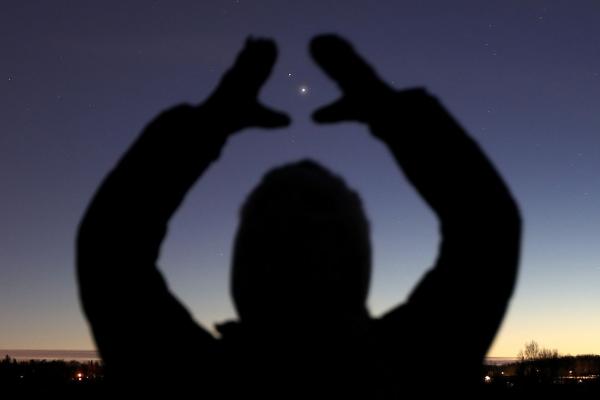What's Up? - Ohio Skylights September 2023

Constellations, Planets, and Astronomical Events Visible in September 2023
The astronomical start of the fall season is fast approaching! The Autumnal Equinox occurs on September 23rd. Equinox gets its name from the fact that the sun spends equal time above and below the horizon on this day. The equinox and solstices, as well as the seasons themselves, are caused by the tilt of the Earth. Earth rotates around its axis and orbits the sun, but there is an angular difference between the rotational and orbital axes, a ‘tilt’ of approximately 23.5 degrees. As highlighted in the diagram, the equinoxes occur when the entire day-side of the Earth is receiving sunlight at the same angle. The solstices (and the summer and winter seasons) occur when one hemisphere is tilted towards the sun, therefore one hemisphere receives more direct sunlight than the other. This is also why seasons are switched in the northern and southern hemispheres.
After the blue moon in August, the next new moon occurs on September 15th. Especially due to the string of supermoons this season, observing during a new moon is much better for viewing fainter objects. The full moon occurs on September 29th, and this will be the last supermoon of the year. A supermoon occurs when there is a full moon at perigee, the closest point to Earth in the moon’s orbit. Since the moon is closer to the Earth than average, it appears larger and brighter in the sky. The image below shows the difference in size of the moon at perigee (closest point) and apogee (furthest point).
Mercury has shifted to its point of greatest western elongation. While it is still extremely close to our sun, the best chance to observe the planet will be in the early morning before sunrise on September 22nd. Venus will also be visible in the early mornings before sunrise; it will rise on the eastern horizon around 4:15 a.m. Venus is much brighter than Mercury, and further from the sun in our sky, so it is much easier to view this month.
Mars sets only an hour after sunset, so it is only visible for a short time during the night. Soon, Mars will be behind the sun, and it will be completely unobservable for a long stretch of time. Jupiter and Saturn are perfectly visible this month. Jupiter rises around 10 p.m.; Saturn will have already risen and be located high in the sky at sundown. The gas giants are extremely bright; they are popular observing targets with the aid of binoculars or telescopes.
Uranus rises shortly after Jupiter; however, the ice giants cannot be easily observed with the naked eye. Neptune is in opposition this month on September 19th. Opposition is theoretically the best time to observe planets, as this is when they are fully illuminated by the sun. Neptune will still not be visible to the naked eye due to its distance from Earth (29 AU or 2.7 billion miles), but the use of a telescope will greatly improve the ability to take advantage of Neptune’s illumination.
A popular constellation to observe in the fall is Cassiopeia. This constellation depicting the vain Greek queen is above the horizon year-round in Ohio, but this season it begins the night far above the northeastern horizon for easy viewing. Cassiopeia is known for its zig-zag shape of bright stars that can be seen even in areas with considerable light pollution. Cassiopeia is another popular guide constellation; it points the way to the Andromeda Galaxy to the south and the constellation Perseus to the east.
The fall and winter seasons are the best time to view some popular star clusters in this area of the sky. The brightest star in Perseus, called Mirphak or Alpha Persei, is the home of a popular star cluster. In the fall, the Alpha Persei star cluster is above the horizon from sundown to sunup, and it will begin the night higher in the sky as the month progresses.
Another popular star cluster is beginning to make its appearance in the night sky: the Pleiades! This cluster is located in the constellation Taurus, and it rises above the horizon around midnight this month. The Pleiades is an extremely bright star cluster that is visible to the naked eye; though binoculars or a telescope will help in heavily light-polluted areas. It is one of the oldest celestial objects to be discovered due to its brightness, and it is a popular target for astrophotographers. As the autumn season progresses and turns to winter, these star clusters will continue to brighten our sky and provide excellent opportunities to go out and observe!
Sources:
- http://www.seasky.org/astronomy/astronomy-calendar-2023.html
- https://www.timeanddate.com/astronomy/night/usa/columbus
- https://in-the-sky.org/news.php?id=20230919_12_100
- https://stellarium-web.org/
Images Credits:
- Orbit Diagram: https://www.weather.gov/cle/Seasons
- Moon Size: https://moon.nasa.gov/diy-moon-orbit/
- Mercury: https://science.howstuffworks.com/46004-mercury-explained.htm
- Neptune: https://solarsystem.nasa.gov/planets/neptune/overview/
- Constellations: https://stellarium-web.org/
- Pleiades: https://astrobackyard.com/m45-the-pleiades/#:~:text=The%20Pleiades%20star%20cluster%20can,and%20noticeable%20as%20the%20Pleiades.
